Top B2B Prospecting Methods in 2025
Sales professionals must becontinually prospecting, so getting good at it isn't optional; it's essential! Unsure of where to begin? Look no...
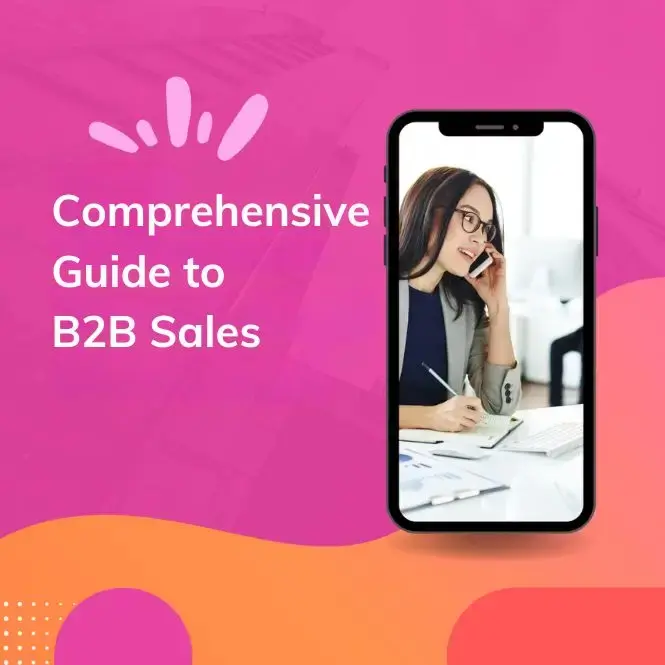
To run your B2B business effectively, expand it and ensure its longevity, it's essential to take control of your lead generation and sales activities.
Achieving this requires a solid understanding of the B2B sales process and successfully leveraging a Digital First Sales Strategy in your Sales Plan.
With over 25 years of experience selling technology solutions in Asia, UK and Europe, I've seen my fair share of sales methodologies, strategies and planning sessions! Not to mention negotiating complex deals, building sales teams, coaching sales managers and the rest!
My point is, sales roles are so varied and consequently there are many different "sales experiences".
When we think of "sales," we can envision things like the art of cold calling, maybe a team of cold calling SDRs running through their call lists, a good old-fashioned lunch meeting, boardrooms filled with teams analysing data and the long-awaited but satisfying handshake that seals a deal.
The world of sales has various forms, from B2B to B2C and B2G sales, constantly adapting to meet changing customer expectations and business demands.
Here, I'm talking about the intricacies of B2B Sales specifically. I will take some time to;
B2C sales involve businesses selling products or services directly to individual customers rather than to other businesses or organisations. Conversely, B2B sales involve businesses selling to businesses.
While both share commonalities in sales strategies, such as fostering relationships and enhancing customer loyalty, they also exhibit distinct differences.
There are five main types of B2B sales targets:

Let’s look at the five types of B2B sales between these parties;
Selling raw materials or components to businesses that manufacture final products falls under this category. Batch process (FMCG and Pharmaceutical), continuous (Oil&Gas), and discrete (IT, Automotive) suppliers along the supply chain supply goods that ultimately form part of the final product, be it cocoa for a chocolate bar or seats for automobiles. These transactions often involve bulk quantities sold at a discounted rate to the buyer. It is common for businesses to establish ongoing relationships with reliable suppliers for regular restocking needs.
Example: Intel makes computer hardware and software and supplies their micro-processors to Dell, Lenovo and HP.
Distributor sales, also known as wholesalers, operate similarly to supplier sales. However, rather than trading in raw materials, distributors acquire finished retail products directly from the manufacturer.
The distributor/wholesaler usually buys directly from the manufacturer, holds inventory of the product, provides after-sale services, and resells the product to resellers and sometimes directly to end users. Because distributors generally take on marketing responsibilities for the product or the obligation to obtain regulatory or government approvals for product resale, the manufacturer-distributor relationship is often exclusive.
A retailer is generally supported by a sophisticated logistics/supply network (2nd,3rd and 4th party) and typically concentrates on B2C selling through either online or 'bricks and mortar' stores.
Example Distributor: Texport supplies its flame-retardant fire suits to Hunter Apparel Solutions, which sells and maintains them for UK & Irish Fire services.
Example Retailer: HP sells its' laptops to Currys.
Intellectual Property Solutions and General Service Providers sell services to other businesses. Depending on the service requirements, the seller may also sell or rent intellectual property in the form of software or provide services businesses have elected to outsource [accounting, legal, IT].
Example: HubSpot offers Software as a Service [SaaS] solutions, allowing companies to subscribe to tailored plans that provide efficient software tools for optimising their growth strategies.
To meet the demands of their communities, government agencies and local councils must acquire various materials, from pens and paper for government facilities to raw materials for construction and maintenance. This type of transaction is commonly known as business-to-government [B2G] sales.
Example: Wylies Copier Supplies sells goods and services to the City of London Department of Commerce to service and maintain their copier fleet.
Charities and nonprofit organisations heavily depend on donations and fundraising efforts, yet they also have essential purchasing needs. Like government agencies, these charitable entities require supplies and services to sustain their operations and fulfil their missions.
Example: Big Business Agency offers HubSpot CRM solutions tailored for NGOs, charities, social welfare organisations, and other nonprofit institutions. HubSpot can enhance donor relationships, streamline donation management and communications, and effectively track budgets, empowering these organisations to fulfil their missions efficiently and effectively.
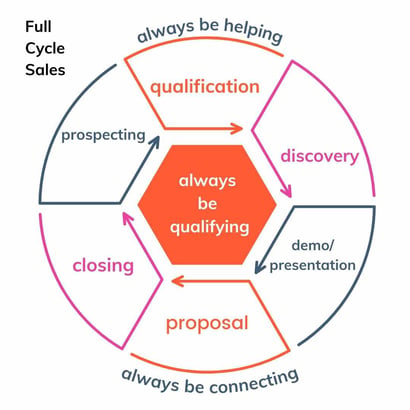
Create Lead Lists: Utilise various channels, including industry events, online platforms, and strategic partnerships, to compile a valuable list of leads. Investing in tools like LinkedIn Sales Navigator can save precious time and money for B2B sales teams of all sizes.
Utilise the Strength of Inbound Marketing: Engage and entice potential leads with impactful content delivered via email, social media, calls, and paid advertising.
Tap into Social Selling: Use social media platforms to connect, engage, and build relationships with potential customers. Data shows that those who put the most effort into social selling reap the biggest rewards. For example, 76% of top-performing sales reps ’always’ research their prospects before reaching out.
And just like most other sales activities, you'll need a framework, such as VECE to be successful!
Click the image below to download your complimentary copy of the VECE Framework
Deals that close have been systematically qualified. Deals are lost because:
1) some key need or parameter for the decision [personal or business] wasn't identified, or
2) the internal budget process and gatekeepers were not mapped, or
3) Internal politics and how they shape the prospects' landscape weren't known.
Conduct IMPACT analysis [or similar methodology]: Evaluate leads based on their Budget, Authority, Need, and Timeline at a minimum. Success comes from qualifying. [Check out 101 Sales Qualification Questions here]
Implement a Scoring System: Prioritise leads based on their engagement and fit with your offerings. Make sure your sales team understand the scoring criteria and apply it consistently. B2B Sales is renowned for troublesome lead scoring systems and this is often because the behaviours that get scored don't correlate with intent to purchase.
Making Initial Contact: Reach out to prospects to gather information and assess how your products and services solve their business needs. "Always be helping" - a "helpful" mindset rather than a "sales" mindset will make it easier for you to connect with your prospect.
Conduct Discovery Calls: Engage in in-depth conversations to understand the prospect's challenges, goals, and pain points.
Dive into Technical Assessment: Ensure that your solution aligns with the prospect's requirements by delving into the technical aspects.
Develop Customised Presentations: Showcase how your technology addresses the prospect's specific needs through personalised presentations.
Provide Demonstrations: Illustrate the functionality and benefits of your technology through live demos or virtual walkthroughs. Invest the time to demo exactly what solves the prospect's business needs. This is one of two critical buying criteria [how me it working].
Share Use Case Presentations: Share case studies with ROI and success stories relevant to the prospect's industry or challenges. This is the second critical buying criterion [tell me who else is using it].
Address Concerns & Objections: Be prepared to address any objections or concerns raised during the presentation. Map out difficult questions and rehearse the answers—especially important when a virtual team is presenting.
Create Customised Proposals: In detailed proposals, outline the proposed solution, pricing, and terms. Constantly relate price to investment and ROI to keep Value at the forefront of the prospect's decision-making process.
Developing Negotiation Strategies: Reach mutually beneficial agreements by developing effective negotiation strategies.
Collaborating on Contract Review: Work closely with legal as early in the process as possible to ensure that contracts meet both parties' expectations.
Confirm the Decision: Understand the prospect's decision-making process and timeline to facilitate a smooth closing.
Employ Closing Techniques: Utilise effective closing techniques based on the prospect's buying signals.
Facilitate Contract Signing: Ensure a seamless process for signing contracts and agreements.
Collaborate on Onboarding: Work with the customer success team to ensure a seamless onboarding process.
Conduct Regular Check-ins: Address post-implementation issues and gather feedback through follow-up meetings.
Identify Upsell and Cross-sell Opportunities: Explore opportunities to upsell additional features or services.
Collect Customer Satisfaction Surveys: Continuously improve the customer experience by collecting feedback with industry standard surveys at least once a quarter.
Implement Referral Programs: Encourage satisfied customers to refer new business through referral programs.
Develop Renewal Strategies: Proactively secure renewals and expand relationships through strategic planning.
Track Metrics: Monitor key performance indicators [KPIs] to evaluate the success of the sales process.
Conduct Meetings with your Sales Team: Discuss wins, challenges, and areas for improvement with the sales team through regular reviews.
It's important to adapt the sales process based on industry trends, competitor analysis, and feedback from the team and customers.
Everyone loves a framework, right? I've listed my top proven frameworks to help you shine in your B2B sales endeavours!
Each serves a unique purpose and when strategically aligned with your business objectives and market, they can pave the way for success.
Getting a feel for your Total Addressable Market is probably one of the first things you'll want to do if you're in a new role. Total Addressable Market [TAM] represents the ultimate potential for a specific product or solution.
Simply put, if every individual who could benefit from a product or solution bought or adopted it [achieving 100% market share], what size would that market be? Once you have established your TAM, and calculated your percentage of that market, you need to prioritise how you will grow your market share.
The Pareto Principle, introduced by Italian economist Vilfredo Pareto in the late 19th century and often referred to as the 80/20 Rule, suggests that approximately 80% of results stem from 20% of the causes. In the context of B2B Sales, this implies that 20% of your customers are responsible for generating 80% of your revenue.
A valuable planning tool for this purpose is Ansoff's Matrix, which provides a framework for leaders to devise strategies for future business growth. Originally featured in the prestigious Harvard Business Review in 1957, this timeless asset continues to offer valuable insights for businesses today.
The Ansoff Matrix equips B2B sales and marketing teams with a straightforward approach to crafting successful growth strategies while also enabling them to evaluate potential risks effectively.
According to Ansoff, there are essentially four key routes to crafting a growth strategy [apart from acquisition], including either diversifying the product offerings [product growth] and/or expanding the target market [market growth].
The Ansoff Matrix presents four strategic growth choices, each varying in risk levels, which can be combined to optimise growth and profitability. See below.

A 2x2 framework designed to evaluate organic growth strategies involving new markets and or new products. Markets occupy the vertical axis, and products or offerings occupy the horizontal axis. Each square in the Ansoff Matrix equates to a specific organic growth strategy –
With decisions made on your growth strategy, you can look to develop your go-to-market strategy. For clarity, a go-to-market plan is not the same as a marketing plan, although a GTM plan should have a marketing plan as a key element. In every strong GTM strategy, there are three key facets to consider:
A typical GTM Strategy includes;
What is the Buyers Pyramid? It's a valuable tool for visualising the market potential for a specific product or service. It outlines the various stages a customer may be in.
The Buyers Pyramid highlights the opportunities for attracting clients. Discover more about the buyers pyramid here
The core concept of the Rule of Seven is straightforward - on average, it takes about seven interactions (or touches, impressions, or engagements) to convert a potential buyer into an actual customer. Experience has shown that a single interaction with a prospect is seldom sufficient to persuade them to purchase your product immediately. Even a few interactions often fall short. Historically, sales and marketing team have found that seven interactions were optimal for encouraging purchases, and thus, the Rule of Seven persists today.
What qualifies as a "contact" under the Rule of Seven? It depends on what you're selling and your target audience. When this rule first emerged, contact with a lead might have involved seeing a billboard, hearing a radio ad, receiving a friend's recommendation, or spotting a newspaper advertisement.
In today's digital landscape, there are more opportunities than ever to deliver marketing content, particularly through video and social media. For B2B outreach, contacts can be more varied and substantial, such as encouraging someone to attend a webinar or read a whitepaper. However, the fundamental principle remains the same: multiple touchpoints are necessary to transition a lead from considering your product or service to purchasing it.
The key aspect of the Rule of Seven isn't the number itself, but the underlying principle: repetition is crucial. Prospects need to encounter your sales and marketing messages multiple times before they decide to purchase. There are several reasons why repetition is essential. Generally, it's easy to see that buyers are unlikely to trust you and make a purchase decision upon their first exposure to your brand. The exception might be if you're offering low-cost, impulse-buy products.
Although it's commonly believed that most people require repeated messaging before taking action, there are no studies that definitively support this. The exact number of interactions needed to secure a sale remains unknown. This doesn't discredit the Rule of Seven, rather, it suggests that for any specific business, the rule might be more accurately described as a "Rule of Ten" or even a "Rule of Fourteen."
This is particularly relevant for B2B companies selling essential, high-value products and services. Your own experiences and data should provide a clearer understanding of how many interactions are truly necessary to close a sale.
The main takeaway? You’ve got to deliver repeat messaging to your prospects. Keep this in mind with your sales sequences and ensure adequate follow ups.
The typical B2B buyer is 70+ % of the way through their purchasing journey before they have an actual meeting with a salesperson. It’s hard to imagine that a single interaction would be enough to get any serious customer more than halfway through their buying process. That’s why it’s critical that you’re creating opportunities for multiple points of contact to occur.
Repeated messaging works on several fairly basic psychological levels. The more we see something, the more easily we remember it, and the more likely it is to pop up in our thoughts.
Repetition creates familiarity, which makes the sales representative’s job easier. They don’t have to start from square one, explaining what your product can do for the buyer.
B2B sales can significantly benefit from repeated contact because the B2B buying process tends to take longer. This means that a sustained effort to keep your brand and products on your prospects’ minds can make or break your chances of closing a sale.
B2B purchasing also frequently involves multiple decision-makers. It can be very advantageous to be the brand that all the buyers have heard about and remember.
To get good fit leads it's crucial your messaging is hitting home with your prospects. Aligning sales and marketing is key in making this happen. Start with identifying the key transition points where potential customers advance from one stage to the next.
These points are crucial for shaping your overall sales strategy. If your marketing efforts aren't producing qualified prospects who reach the end of the sales funnel, it's time to reassess your marketing strategy.
Conversely, if you're consistently generating qualified leads that progress through the funnel, your sales and marketing are effectively aligned.
Understanding where these transitions occur also makes it easier to identify and resolve any issues or obstacles in the process, which is vital for customer relationship management (CRM). Examples of these conversion points in the sales funnel include:
Initial Contact: The first interaction between a lead and a sales representative
Initial Connection: The first discussions where a lead is assessed and becomes a prospect
Demo scheduled: Qualified prospect consents to a demonstration
Demo completed: A sales representative finalises the demonstration for the prospective customer
Quote sent: The stage of negotiation where the specifics of the sale are finalised
Lead generation and demand generation funnels are integral concepts in B2B sales. Gartner have a clear definition of these often confused yet vitally important aspects of B2B Sales.

Demand generation is about gaining the attention of potential customers and nurturing their interest in your products and services. It’s a long-term strategy, but it has a compound impact on all marketing efforts. Over time, quality demand generation efforts result in more brand mentions, high-quality leads and revenue. [Source: Gartner]
In a demand generation funnel, the goal is to spark interest and enthusiasm for the product or service. Different types of content is required for the various stage of the funnel.
The stages of a Demand Generation Funnel include;
Awareness - (Attract)
Consideration - (Engage)
Evaluation - (Engage)
Conversion - (Engage)
Lead generation, on the other hand, is about identifying prospects that express interest in your products and services and capturing their contact information. It’s a short-term marketing strategy with the goal of initiating sales conversations.
Both demand and lead generation are interconnected strategies and work together in moving prospects down the sales funnel. Demand generation is higher up in the funnel and builds the foundation for lead generation activities commencing in the middle of the funnel. [Source: Gartner]
A Lead Generation Funnel is designed to identify and engage with customers who show interest in your products or services.
The stages of a Lead Generation Funnel typically include:
MQL, SQL, SAL.... Let's keep it simple!
Marketing Qualified Leads (MQLs) often face criticism from sales folk due to their perceived low quality. Poor quality leads usually stem from flawed assessment methods. It's definitely worth investing time to figure out how lead quality can be improved.
The first step should be collaborating with marketing to refine the lead scoring process. This single action should quickly improve the quality of MQLs.
Utilise lead management software to centralise all your contact data, allowing you to personalise prospect outreach without searching for details.
Access the history of each lead and prioritise leads using tailored scoring criteria. Check out the video below for more information.
Identifying and targeting prospects involves focusing on specific groups who are most likely to be interested in your products and services. To achieve this, you develop an ideal customer profile, (ICP) which outlines the characteristics of the perfect customer for your product.
This includes considering their demographics, needs, locations and other relevant details. This approach helps you understand who your best customers are and how to effectively reach them.
By focusing on customers and developing an ideal customer profile in your sales plan, you can efficiently direct your efforts towards those most likely to purchase from you. This approach allows you to tailor your sales and marketing strategies, thereby enhancing your likelihood of achieving successful sales.
TOP TIP: Prioritise following up with leads that are a good fit for your ICP and reach out to those ICP companies that show buyer intent.
A valuable tool to help identify potential challenges and pain points, buyer personas can help you identify priorities for your buying committee and focus messaging for your content.
B2B marketing concentrates on strategies that entice leads to reach out to you. The marketing process should centre around activities such as search engine optimisation( SEO) to make sure that potential leads end up on your website and content marketing that makes the lead want to learn more about your product and opt-in email marketing.

Forecast Accuracy is driven by two essential techniques: Qualification and Standardisation. As we mentioned Qualification above [IMPACT framework], let's look at how implementing Standardisation can improve forecast accuracy.
B2B Sales teams need a clear understanding of the specific pieces of information required before they can confidently move a deal forward to the next stage in the sales pipeline. A shared understanding of what evidence is needed for a deal to progress through the pipeline simplifies sales management and increases forecast accuracy.
![]() Without a standard view of what these essential pieces of information are, sales teams will interpret and, through best efforts, present an inconsistent pipeline. Imagine a scenario where one team member believes that customer budget is the most important factor to verify, while another team member focuses on the customer's decision-making process.
Without a standard view of what these essential pieces of information are, sales teams will interpret and, through best efforts, present an inconsistent pipeline. Imagine a scenario where one team member believes that customer budget is the most important factor to verify, while another team member focuses on the customer's decision-making process.
These [along with four others] are all critical data points to qualify a deal and its correct place in the pipeline. Only with a shared understanding of precisely what each of these six data elements is, can the timing of each deal be correctly judged. Similarly, revenue projections can only be accurate if there is a consensus on the essential information needed for each stage of the sales process.
The primary objectives of effective pipeline management encompass establishing a robust pipeline and securing more deals to make quota. Studies indicate that companies commonly evaluate pipeline vitality based on its size, structure, and composition. Achieving deal closures often hinges on targeted coaching tailored to individual opportunities. Thus, if you are assessing the overall health of your sales pipeline or guiding your sales representatives towards closing deals, you are likely on the right track.
The primary objective of forecasting is to make precise predictions about future performance. As you get deep into the realm of forecasting, you rely on three key assumptions: the deal size, the probability of winning the deal, and the anticipated closing date.
For instance, when you communicate, "there is a 25% chance that this £50,000 deal will close next quarter," you are engaging in forecasting. By leveraging these assumptions, you estimate when your revenue will materialise. While accurate forecasting won't directly impact your likelihood of winning a deal or the health of your pipeline, it will enhance the precision of your predictions, ultimately advancing the goal of forecasting.
Whether you’re selling IT Services to Government Clients or CRM Solutions to startups, or small businesses it’s important to have a sales strategy to guide you through the process.
Establishing a B2B sales strategy lays the groundwork for reaching your business objectives by mapping out a definitive course of action. Given that every business has its distinct sales goals, strategies can differ. To embark on your sales expedition, here are key B2B sales strategies to steer you in the right direction.
Download a free copy of our information-packed Social Selling Guide and get up to speed on the latest strategies for social selling.
Learn how to put Social Selling at the heart of your sales process for accelerated sales results.
The B2B Inbound sales funnel is a great visual guide to help you navigate your sales strategy. An Inbound strategy can be employed in various ways, such as creating blog posts and ebooks, developing tools, engaging on social media, hosting podcasts or YouTube channels, optimising for search engines to drive traffic to your website, or running opt-in email campaigns.
Inbound involves any strategy where the customer initiates contact with you, rather than the other way around. The cornerstone of an Inbound Strategy is providing helpful content to assist your potential customers in their research and to support them in their buyers journey.
The sales funnel provides a useful framework for the process, regardless of the marketing plan you choose. Every lead that becomes a prospect and eventually a customer will progress through the same stages of the funnel.
The B2B Outbound sales funnel offers a structure for your B2B sales approach, enabling you to actively contact potential clients and create leads. In contrast to Inbound sales, which centres on drawing in and engaging customers through content and marketing initiatives, outbound sales depends on the following activities conducted by sales teams:
For more information refer to previous section "what are the steps in B2B Sales Process"
Product training is not the same as sales training. You need to invest in both to have a top-performing sales team.
Today’s B2B buyers are savvier, more informed, and have access to several options at their fingertips. What makes it more complicated is that 90% of buyers don’t follow a linear sales funnel path, leaving sales reps little to no room for mistakes.
This makes B2B sales training more important than ever. A well-designed training programme will empower sales reps with the knowledge they need to deliver value and close more deals. Let's take a look at what you need to consider when you're thinking about Sales Training.
Begin every training program with a thorough needs assessment. Evaluate the sales team's existing skills, pinpoint areas for enhancement, and align the training with your business objectives. This critical step guarantees that the training is tailored, pertinent, and impactful.
Customise the sales training modules to meet the specific needs identified. Develop modules that encompass industry-specific knowledge, practical sales scenarios, comprehensive product understanding, and essential sales and soft skills.
Selecting the right training methods and resources is vital to captivate your team. This entails discovering the perfect blend of face-to-face, hybrid, or virtual sales training tailored to your team's locations and preferred learning styles. Integrate interactive activities and practical materials such as role-playing and case studies to enhance the learning journey.
Ensure your training programme integrates your sales methodology. Whether Inbound, SPIN, Sandler or something else, make it a focus area. Offer materials and exercises that reflect the methodology’s sales strategies and principles so sales reps can apply the techniques in real-world scenarios. For a comprehensive review of the Top 12 B2B Sales Methodologies, you can read our recent blog article.
Set clear metrics and KPIs to track the success of your sales training program and consistently collect feedback from participants for ongoing enhancements. This method will evaluate the training's influence on B2B sales performance and guarantee it provides concrete business advantages.
The elephant in the [training] room
Regrettably, a staggering 87% of the training provided to sales trainees through conventional learning management systems is forgotten within just a month. Given this challenge, how can you ensure that your B2B sales training program effectively equips your team for success? Let's delve into best practices that can enhance the impact of your sales training.
TOP TIP: Discover the wealth of knowledge available at HubSpot Academy, which offers self-paced sales and marketing training covering a diverse range of topics. Stay ahead of the curve with training and insights into the newest trends in digital marketing, sales strategies, customer support, and CRM innovations. Best of all, get access to these resources at no cost and earn certifications along the way.
For further information visit HubSpot Academy.
The landscape of B2B sales is constantly shifting, with businesses seeking that edge or a new trend that distinguishes them from competitors. Here are some anticipated B2B sales trends for the upcoming year.
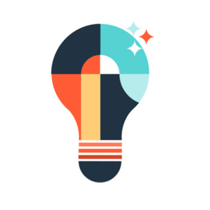 AI and automation: Businesses are finding new benefits to implementing AI in sales. AI can analyse data in real-time and use data algorithms to automate data-heavy or cognitive tasks. Conversational AI tools [like Breeze Copilot] use machine learning to improve with each interaction, and predictive AI tools can accurately forecast sales. HubSpot AI assistant can draft sales emails, create draft blog articles, create email templates and more, freeing up valuable time for sales teams to connect with prospects and customers. Read more on Sales automation and AI
AI and automation: Businesses are finding new benefits to implementing AI in sales. AI can analyse data in real-time and use data algorithms to automate data-heavy or cognitive tasks. Conversational AI tools [like Breeze Copilot] use machine learning to improve with each interaction, and predictive AI tools can accurately forecast sales. HubSpot AI assistant can draft sales emails, create draft blog articles, create email templates and more, freeing up valuable time for sales teams to connect with prospects and customers. Read more on Sales automation and AI
Breaking down data barriers: Collaborative data sharing is a game-changer, and savvy businesses are fully aware of its advantages. By investing in tools that locate, unify, and structure scattered data in a centralised platform, companies can significantly optimise their sales operations.
Personalisation and nurturing relationships: Gathering customer data and organising it in a centralised hub like HubSpot, empowers sales professionals to glean insights from ongoing interactions, context, and past engagements. By proactively engaging with customers and providing seamless sales experiences, relationships can be nurtured and strengthened.
Level up sales team skills: Over 70% of sales leaders prioritise enhancing the capabilities of their sales representatives. In-house training initiatives and skill development programs not only empower sales reps to excel in their positions but also contribute to bolstering employee retention rates.
Invest in a powerful CRM: Eight per cent of people surveyed in the State of Sales Report said their business is increasing its CRM and sales tools budget. Tools like AI and automation in Sales Hub can enhance efficiency, while collaboration tools can create more and better sales opportunities for B2B sales teams.
There is no doubt about the need for Territory Plans, Account Plans, Opportunity Plans, Bid Reviews, Win/Loss Reviews, Pipeline Reviews, QBRs - all of those activities that are non-selling and take up so much time.... they are not going away anytime soon. Sorry, but I guess you knew that! However, with the rapid advancement of technology, tasks like research, creating custom reports and preparing supporting materials are now quicker and more efficient, thanks to AI.
Salespeople are benefiting from increased productivity when it comes to researching prospects and creating content for presentations and emails. And, it's not just salespeople that are benefitting, buyers are increasingly making the move digital sales and consistently doing more research online than they have previously. Sales need to align with the buyer's journey to maintain a competitive advantage and to give customers a better experience.
The evolution of sales will see a permanent shift in organisations' sales strategies, processes, and resource allocation, transitioning from a focus on sellers to a customer-centric approach. Embracing digital-first engagement is essential as digital sales channels growth will continue to accelerate. This means moving away from traditional sales methods to automated processes, blending various capabilities to enhance customer interactions and drive sales effectiveness.
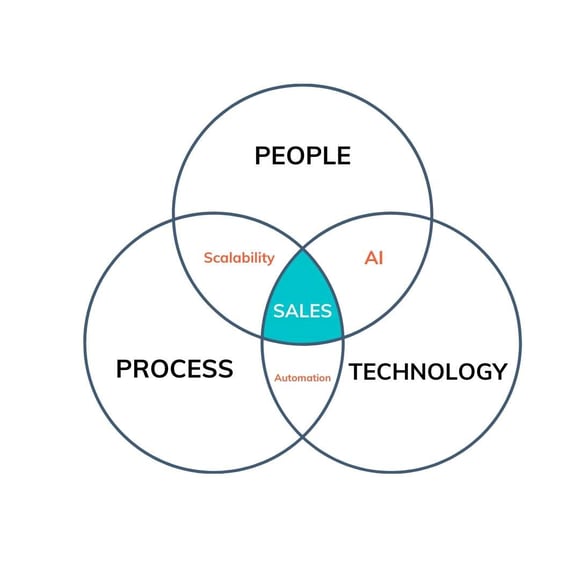
B2B sales can be challenging, but with the right tools and processes, it can be a lot easier for your sales team and more enjoyable for your customers.
HubSpot makes leaning into AI and Automation easy. The HubSpot Customer Growth Platform has AI built in giving you productivity gains with AI content assistants helping with email, webpages and blogs, Chatbots for live help, Predictive Deal Health Scoring and AI assisted reports and much much more... pair this with workflows and the difference in your processes is significant.
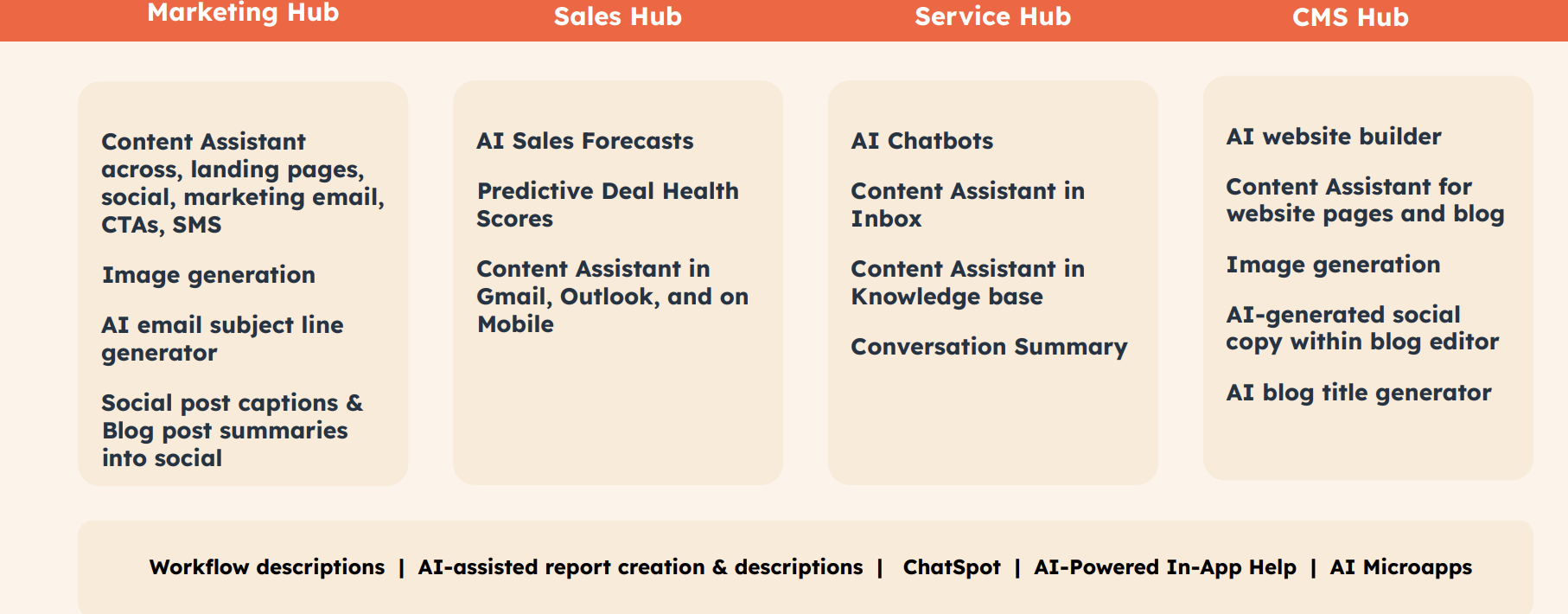
With HubSpot Sales Hub, you get a unified platform with everything you need—a dedicated prospecting workspace, automated lead follow-up, sequences, email, email tracking, calling, meeting scheduler, sales snippets, quotes, payment links, and collaboration tools—all in one place.
The set-up is fast, and unlike other sales-focused CRMs, it's easy to learn and use, which makes user adoption a walk in the park!
A successful move to Full-Cycle Sales should be viewed as a Change Program that affects People, Processes, and Technology.
Like all changes, it has the best chance of success when the transition is managed, planned and resourced like a project, for more information check out our page Full Cycle Sales Enablement and our blog, McKinsey's 7S Model for implementing full cycle sales
There are several things to consider, such as the size of your sales team and which industry you work in and the experience and maturity of your sales people. Read the Top 12 B2B Sales Methodologies to get an overview of the popular sales methodologies and use this as a starting point to research your options.
As more and more B2B buyers move to research online it makes sense for sellers to move more of their efforts online too. Meeting your buyers where they are means establishing where your buyers spend time online. This could be on Twitter, LinkedIn or another platform.
Developing relationships online and providing helpful content is the foundation of social selling.
For more information, read our article what is social selling? here
No, these are two different things.
Opportunity Plans are created for large complex opportunities with multiple stakeholders both internal (inside your company) and within the account (your prospect or customer).
Opportunity Plans map out the roles/responsibilities/timelines/communication plan/win themes/SWOT analysis/pricing strategies/compelling event/negotiation strategy and much more for a specific sales opportunity over a certain monetary value.
Account Plans map out the Background of the Company, (Company mission statement and vision/background and history/number of employees/annual revenue/industry/target markets) Account Map - the org structure, political mapping, information on the relationship over time and future direction of company, share of wallet and much more.
Would you like to find out more or have a quick chat?
Use this Meeting Link and choose a time to talk.

Sales professionals must becontinually prospecting, so getting good at it isn't optional; it's essential! Unsure of where to begin? Look no...

Training and Coaching your sales team is what makes the difference between good and great...